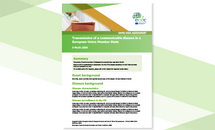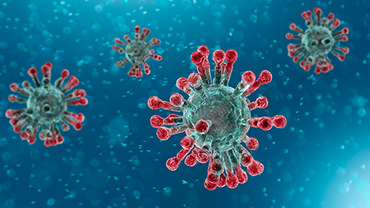Risk assessment: Outbreak of severe acute respiratory syndrome coronavirus 2 (SARS-CoV-2): increased transmission beyond China – fourth update
On 31 December 2019, a cluster of pneumonia cases of unknown aetiology was reported in Wuhan, Hubei Province, China. On 9 January 2020, China CDC reported a novel coronavirus as the causative agent of this outbreak, which is phylogenetically in the SARS-CoV clade. The novel coronavirus has thus been named ‘severe acute respiratory syndrome coronavirus 2’ (SARS-CoV-2), while coronavirus disease associated with it is now referred to as COVID-19.
Executive Summary
As of 13 February 2020, 9:00, more than 60 330 cases of COVID-19 have been reported worldwide, mainly in China and from all Chinese provinces; of these cases, more than 450 cases were reported from other countries. As of 13 February, 13 countries reported local transmission: the United Arab Emirates, Canada, France, Germany, Japan, Malaysia, South Korea, Singapore, Taiwan, Thailand, the United Kingdom, the United States of America and Vietnam.
In the EU/EEA and the UK, 44 cases have been reported as of 13 February. Among them, 21 are locally acquired: Germany (14), France (6) and the UK (1). All of these cases have epidemiological links to earlier identified clusters with importations from outside the EU/EEA and the UK.
See updates on the epidemiology of SARS-CoV-2.
According to available evidence, the transmissibility of this virus is assessed as sufficient for sustained community transmission. Further cases and deaths in China are expected in the coming days and weeks. Further cases or clusters are also expected from other countries that are already reporting increasing numbers of cases, including community transmission. Therefore, health authorities in the EU/EEA and the UK should remain vigilant and strengthen their capacity to respond to possible importation of cases from China or, potentially, other areas with presumed ongoing community transmission; increase their capacity for surveillance and review their pandemic preparedness plans.
There are considerable uncertainties in assessing the risk of this event, due to lack of detailed epidemiological analyses.
ECDC assesses the risk based on the probability of transmission and the impact of the disease. On the basis of the information currently available, the Centre’s assessment is as follows:
- The risk for healthcare systems capacity in the EU/EEA and the UK that would arise in the face of widespreadtransmission of SARS-CoV-2 at the peak of the influenza season is considered to be low to moderate.
- The risk associated with SARS-CoV-2 infection for the EU/EEA and UK population is currently low.
- The risk for people from the EU/EEA/UK travelling/resident in areas with presumed community transmissionis currently high.
What is new in this update
- Updated number of cases in and beyond China
- Description of cases and transmission reported in the EU/EEA and the UK
- Findings on disease and transmissibility from recent studies
- Risk to the healthcare systems in the EU/EEA and the UK
- Risk to citizens from the EU/EEA and UK travelling or living in areas with presumed community transmission
- ECDC guidance documents (listed under ‘Options for response’).
Download
Latest updates
Public health guidance
Guidelines for the implementation of non-pharmaceutical interventions against COVID-19
These ECDC guidelines detail available options for NPI in various epidemiologic scenarios, assess the evidence for their effectiveness and address implementation issues, including potential barriers and facilitators.
Surveillance and monitoring
Health emergency preparedness for imported cases of high-consequence infectious diseases
To support countries in the European Union/European Economic Area (EU/EEA) in their review of preparedness system planning, ECDC launches an operational checklist for health emergency preparedness for imported cases of high consequence infectious diseases.
Public health guidance
Personal protective equipment (PPE) needs in healthcare settings for the care of patients with suspected or confirmed novel coronavirus (2019-nCoV)
The aim of this document is to support public health preparedness planning with regard to personal protective equipment (PPE) needs in healthcare settings where patients suspected or confirmed to have been infected with the novel coronavirus 2019-nCoV are being treated.
Public health guidance
Safe use of personal protective equipment in the treatment of infectious diseases of high consequence
This ECDC tutorial provides practical information on the proper use of PPE at the point of care, including technical requirements and procurement aspects.
Areas with presumed community transmission of COVID-19
As of 2 March 2020, ECDC no longer defines areas of presumed community transmission. Please refer to WHO situation reports for country classification [hyperlink: https://www.who.int/emergencies/diseases/novel-coronavirus-2019/situation-reports/






